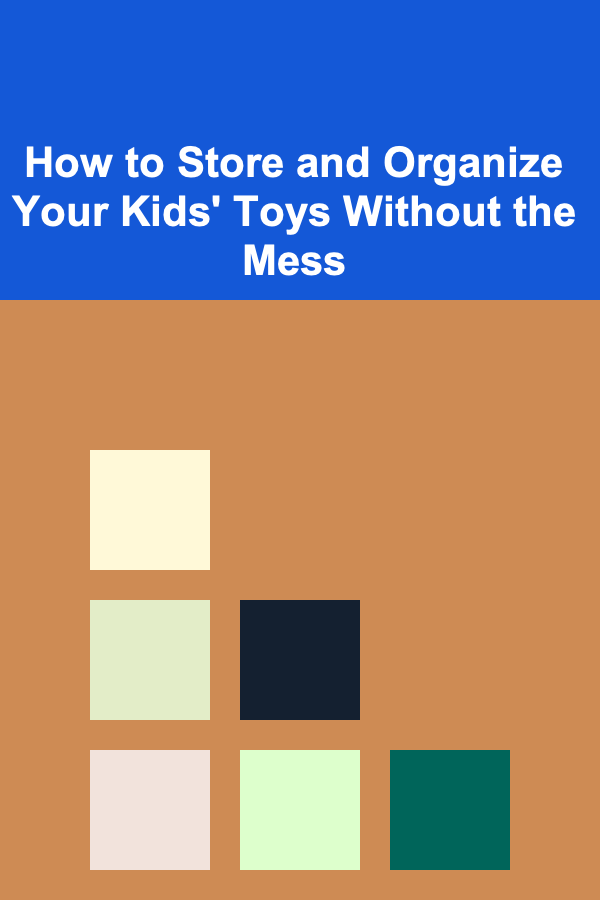
How to Store and Organize Your Kids' Toys Without the Mess
ebook include PDF & Audio bundle (Micro Guide)
$12.99$9.99
Limited Time Offer! Order within the next:

As every parent knows, toys have a magical way of multiplying and spreading across the house, turning your once tidy home into a chaotic playground. While it's natural for children to enjoy playing with their toys, the aftermath often involves cluttered living rooms, bedrooms, and play areas, making it feel like an ongoing battle to maintain order. The good news is that organizing kids' toys doesn't have to be a daunting task. With the right strategies and storage solutions, you can reduce the mess, encourage your kids to clean up, and create an organized play space that is both functional and aesthetically pleasing.
In this article, we will explore various strategies and practical tips on how to store and organize your kids' toys without the mess, while considering different factors such as toy types, space constraints, and fostering a sense of responsibility in children.
Start with a Declutter
The first step in any successful organizing project is decluttering. Before you start thinking about storage solutions, it's essential to take stock of the toys you already have and determine which ones are worth keeping. Kids grow quickly, and their interests change, so there are likely toys that are no longer played with or need to be replaced due to wear and tear.
1.1 Evaluate What to Keep and What to Donate
Go through the toys with your child, and together, assess which ones they still enjoy and use. Consider the following:
- Condition of the toys: Are they broken or missing pieces?
- Age appropriateness: Is your child still at the right developmental stage for certain toys?
- Duplicates: Do you have too many of the same type of toy, such as multiple dolls or action figures?
- Interest level: Is the toy something your child regularly plays with or has lost interest in?
By involving your child in the decision-making process, you not only reduce the number of toys in your home but also help teach them valuable lessons about tidying up, sharing, and giving. Items that are in good condition but no longer needed can be donated to others, reducing waste while benefiting those in need.
1.2 Dispose of Broken or Outgrown Toys
Don't hold on to toys that are broken beyond repair or are no longer safe for your child to play with. Toys that are missing parts or don't function properly can create unnecessary clutter and frustration when your child wants to play. Likewise, if your child has outgrown certain toys, there's no need to keep them around.
Categorize the Toys
Once you've decluttered, the next step is to categorize the toys into groups. This makes it easier to store them in an organized manner and helps your child understand where to place each toy when it's time to clean up.
2.1 Group by Type or Function
Consider organizing toys by their type or function. For example:
- Building blocks and construction toys: Group all building materials like Lego sets, wooden blocks, and other construction toys in one place.
- Stuffed animals: Group plush toys together.
- Action figures and dolls: Keep figurines and dolls in separate bins.
- Art supplies: Crayons, markers, paints, and drawing paper can be grouped into an arts-and-crafts category.
- Educational toys: Organize toys designed for learning into their own category, such as puzzles, flashcards, and interactive learning devices.
2.2 Group by Frequency of Use
Not all toys are used equally. Some toys are pulled out daily, while others might only be used occasionally. By grouping toys based on how often they are used, you can prioritize the storage spaces accordingly. For example:
- Everyday toys: Keep toys that your child plays with frequently in easily accessible areas.
- Occasional toys: Items like board games, puzzles, and special toys can be stored in a more distant location or higher shelves.
Maximize Storage Space
One of the most important elements of organizing kids' toys is finding adequate storage solutions. Here are several ways to maximize storage space while keeping toys organized.
3.1 Use Clear Bins and Containers
Clear plastic bins are an excellent storage solution for toys. They allow you to see the contents without having to open every single box, making it easier for both you and your kids to find the toys they're looking for. Label each bin based on the toy category, such as "Legos," "Cars," or "Plush Animals." Clear bins are particularly helpful for older children who can learn to put their toys away on their own.
3.2 Invest in Toy Storage Furniture
Toy storage furniture comes in a variety of styles, such as shelving units, toy chests, and storage benches, which can help you organize toys while serving as a functional part of the room's decor. Some toy storage units even have built-in compartments or cubbies, making it easy to store small toys. Consider the following:
- Storage benches: These work well for large toys or stuffed animals. You can even sit on them while you help your child clean up.
- Cube organizers: Use these with fabric bins or baskets for flexible, categorized storage.
- Open shelving: Ideal for larger toys that don't fit into bins, such as dolls, cars, and toy houses. Shelving makes toys easily accessible and gives your child the opportunity to independently choose what they want to play with.
3.3 Use Vertical Storage Solutions
If space is limited, think vertically! Wall-mounted shelves, hooks, and pegboards can be excellent solutions for storing toys and play materials. These options can help free up floor space while keeping toys within reach. For instance:
- Wall shelves: Use shelves to store books, figurines, or toys that can be stacked.
- Hanging organizers: Hang small bags or pouches on the back of a door or on a wall for storing smaller items like toy cars or action figures.
- Over-the-door organizers: These are perfect for holding toys that don't require heavy-duty storage, like stuffed animals, art supplies, or blocks.
3.4 Use Toy Organizers with Labels
One of the keys to maintaining an organized system is making it easy for your kids to identify where everything goes. Invest in toy organizers with built-in labels or attach your own. Labeling each section with pictures for younger kids or words for older ones can help them understand where everything belongs and encourage them to clean up after themselves. Consider color-coding for an additional visual cue.
Create Play Zones
Another useful tip for organizing kids' toys is to designate specific areas for different types of play. Creating clear play zones not only helps keep the toys organized but also encourages your child to focus on one activity at a time.
4.1 Designate Activity Areas
Separate different areas in the room based on the type of play:
- Building area: A corner with a sturdy table or play mat where your child can build with blocks, Legos, or other construction toys.
- Reading nook: A cozy area with shelves for books and soft seating where your child can enjoy reading or looking through picture books.
- Art station: A table or designated corner for arts and crafts, where your child can store supplies like crayons, markers, and coloring books.
4.2 Rotate Toys
To keep the clutter from getting overwhelming, consider rotating your child's toys. Instead of keeping every toy available at once, store some of them out of sight and rotate them every few weeks. This allows your child to rediscover toys they haven't played with in a while and keeps the space from feeling overcrowded with too many toys.
Involve Your Kids in the Organizing Process
Organizing kids' toys can be a fun, educational activity if you involve your child in the process. By making them a part of the decision-making and organizing steps, you teach them valuable skills and help them understand the importance of cleanliness and organization.
5.1 Teach Responsibility
Teach your children the importance of tidying up and maintaining an organized space. Even young children can participate in cleaning up by sorting toys into designated bins or shelving units. Make it a routine and part of the end-of-playtime ritual to encourage consistent habits.
5.2 Make It Fun
You can make the toy cleanup process more enjoyable by turning it into a game. Set a timer and challenge your child to clean up as quickly as possible. You could also play a game of "who can put away the most toys in 2 minutes?" or make a song out of the process to make it lighthearted.
5.3 Encourage Independence
As your child grows, encourage them to take on more responsibility for organizing and tidying up their toys. Older kids can help with the sorting process, while younger kids can learn how to identify where each toy belongs. Gradually increase their independence in cleaning up their toys, and celebrate their efforts.
Regular Maintenance
Once your toys are organized, it's important to maintain the system. Set aside time to periodically go through the toys, especially if new toys are added. Keep an eye on toy condition and discard or donate those that are no longer used or need repair. This way, the toy organization system remains functional and manageable.
6.1 Make Cleanup a Routine
Establish a routine for cleaning up. Whether it's at the end of the day or after each play session, make sure that your child knows when it's time to tidy up. Consistency is key in ensuring the space stays organized and that your child develops good habits for cleaning up after themselves.
Conclusion
Organizing your kids' toys doesn't have to be an overwhelming task. With careful planning, the right storage solutions, and consistent routines, you can create a clutter-free play area that encourages your child to engage with their toys while maintaining a sense of responsibility and order. Remember to involve your child in the process, keep things simple, and rotate toys to prevent overwhelm. A little effort in organizing toys today will save time and energy in the future, and make your home a more peaceful and organized space for everyone.
Reading More From Our Other Websites
- [Organization Tip 101] How to Keep Snacks and Drinks Handy Without Clutter
- [Home Pet Care 101] Creating a Safe and Fun Environment for Your Rabbit
- [Home Party Planning 101] How to Create the Perfect Party Ambiance with Candles and Mood Lighting
- [Scrapbooking Tip 101] Eco-Friendly Scrapbooking: Sustainable Paper Options and Where to Find Them
- [Home Rental Property 101] How to Build a Good Relationship with Your Tenants
- [Home Soundproofing 101] How to Soundproof a Child's Bedroom for Better Sleep
- [Organization Tip 101] Best Practices for Maintaining and Cleaning Your Flooring
- [Personal Finance Management 101] How to Reconcile Roth IRA vs. Traditional IRA with Your Personal Financial Goals
- [Star Gazing Tip 101] Eco-Friendly Aurora Tours: Sustainable Ways to Experience the Night Sky
- [Personal Care Tips 101] How to Choose a Perfume That Matches Your Mood

How To Improve Your Decision-Making Under Pressure
Read More
How to Plan a Holiday Party with a Personal Touch
Read More
How To Master Crisis Leadership
Read More
How to Bootstrap Your Way to Profit
Read More
Navigating Language Exchange Apps Safely: A Comprehensive Guide
Read More
10 Tips for Staying Comfortable on Overnight Train Trips
Read MoreOther Products

How To Improve Your Decision-Making Under Pressure
Read More
How to Plan a Holiday Party with a Personal Touch
Read More
How To Master Crisis Leadership
Read More
How to Bootstrap Your Way to Profit
Read More
Navigating Language Exchange Apps Safely: A Comprehensive Guide
Read More